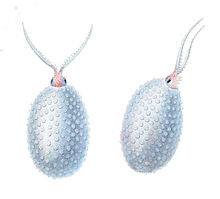Species of squid
Cranchia scabra is a species of glass squid. It is the only species in the genus, and is fairly small (about 150 millimeters (5.9 in)). They reside in the epipelagic zones of the tropical Atlantic. The genus contains bioluminescent species. It is named for John Cranch who described this species.
Anatomy and Morphology
Tubercles
The mantle is covered by large, multi-pointed cartilagenous tubercles. C. scabra are often characterized by their complex tubercles which are projections or protuberances on their surface. The scanning electron microscope has been used to inspect the tubercles.[1] Tubercles may vary from small and simple nodules, to large with a complex Maltese cross form. The tubercles may provide some type of protection, but it is unclear which predators are affected and how.
Dorsal and Ventral Chambers
These squids have a horizontal partition over the mantle cavity. The mantle cavity is divided into 2 dorsal chambers and 1 ventral chamber. An opening in the posterior end of the horizontal membrane connects the dorsal chamber to the ventral chamber. An inhalant opening on the head connects the exterior portion of the horizontal membrane between the dorsal and ventral chamber. A thin membrane is attached to the anterior border of the head and mantle located along the borders of the dorsal and ventral chambers. This thin membrane keeps water from exiting the dorsal chamber. Water can exit the ventral chamber via a small funnel.[2]
Photophores
Light-emitting organs known as photophores around the eyes of this squid allow them to see in the dark and this light can also deter any predators. Additionally, female squids have photophores on the tips of their arms which may help attract mates.[3]
Habitat and Distribution
In terms of distribution, Cranchia scabra are distributed across the globe in tropical and subtropical open ocean waters. Paralarval and juvenile squids are found in the epipelagic to upper mesopelagic zones of the ocean while adult squids move into the mesopelagic and bathypelagic zones up to 2000m deep.[6]
Behavior
Movement
C. scabra are considered to be neutrally buoyant animals due to ammonia fluid in their cavities. They change orientation and position with rapid movement of their fins. In captivity, C. scabra has been shown to contract its mantle which caused rapid backward movements over a distance of 3-4 body-lengths. Immediately after these contractions, the mantle maintained its contracted shape, but slowly recovered its original, globular shape. Since the mantle shape was very slowly regained and these contractions are used infrequently, researchers have suggested that these short movements are used as escape reactions rather than continuous movement.[7]
When disturbed, the squid often pulls its head and arms into the mantle cavity and folds its fins tightly against the mantle to form a turgid ball. In addition, the squid may ink into the mantle cavity, making the ball opaque. This was thought to be an aberrant behavior due to the stress and confinement of shipboard aquaria, until the same inking behavior was seen in cranchiids from submersibles. The exact function of this behavior is unknown, however inking could help them change color or be used as a chemical weapon against any predators.[8]
Growth
Cranchia scabra are some of the fastest growing squids. During the first 4–5 months of their development, C. scabra feed and grow very rapidly in epipelagic waters. They move into deeper waters to mature and spawn. Statoliths are calcareous structures found in cephalopods which detect body accelerations throughout movement. There are two growth zones in statolith microstructures: translucent postnuclear and pale white opaque.[9]

